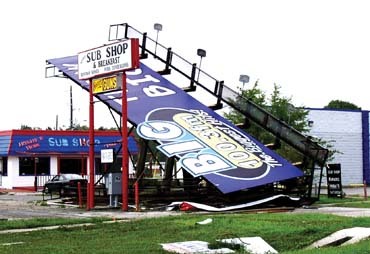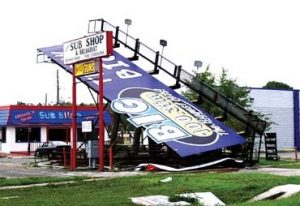Hurricanes Katrina, Rita and Wilma exacted a heavy toll on people and property along the Gulf Coast. Our hearts and prayers are with those who suffered through these tragedies. If the damaged sign conforms to the various height, size and other regulations currently imposed by the applicable governmental jurisdiction, repairing it should elicit few, if any, legal concerns. Often, jurisdictions require permits to repair conforming signs, so the local building, sign or other official should be consulted about necessary fees and inspections before proceeding with the repairs. However, regardless of the extent repairs are subject to such permit, inspection and fee requirements, and regardless of the degree of damage, they should be readily authorized for conforming signs. Nonconforming signs present more difficulties. For example, assume the sign was legal, permitted and compliant with all local regulations when it was constructed. Subsequently, however, the regulatory authority amended the sign ordinance, and the new height or size specifications were lower or decreased. Or, perhaps the municipality passed new regulations that completely prohibit the type of sign originally constructed, say, pole signs or off-premise advertising. Such regulations, passed after the original sign construction, render the sign “nonconforming” or “grandfathered,” meaning it can legally continue to exist despite its failure to comply with the current regulations. Most sign, zoning or other land-use regulations prohibit expanding or exacerbating the nonconformity, such as increasing the height or size of a sign that’s already too tall or large. Such regulations also usually contain provisions for eventually terminating nonconforming uses or structures. One such means, for example, is to prohibit the repair of nonconforming uses and structures that have been “substantially damaged.” Thus, if the nonconforming sign was substantially damaged in a hurricane, it could only be repaired in compliance with the current height, size and other regulations applicable to the sign. As part of the repairs, therefore, the sign would have to be lowered or downsized. In fact, the sign would have to be completely removed if the current regulations prohibited all signs of such type. Sign ordinances must contain sufficient definitions, guidelines or other objective tests to determine when the sign damage is “substantial,” so that sign owners are given fair and reasonable notice of what repairs are permitted or prohibited. Most jurisdictions’ regulations have met this constitutional requirement for due process and specificity, such as comparing the cost of repairing the storm damage with the cost of rebuilding the sign. For example, Section 4605(e)(3) of the Houston sign code states, if the cost of repairing the damaged sign exceeds 60% of the cost to rebuild it, then the sign will be permitted for repair only if it complies with the current sign code’s height, size and other limitations. Thus, if the sign was originally built at a height of 70 ft., and the repair cost was 61% or more of the cost of rebuilding it, the sign would have to be lowered to the permitted height of 42 ft. when the repairs were conducted. By contrast, if the cost to repair the storm damage was only 59% of the cost to rebuild it, the repairs could occur, and the sign could remain at the nonconforming height of 70 ft. Each regulatory authority has different procedures for implementing this test. For example, the Houston Sign Administration requires the sign owner to submit two bids from licensed sign contractors that compare the cost to repair and rebuild the damaged sign. An official from the Houston Sign Administration then inspects the sign and analyzes the estimates, and the department will then issue or deny repair permits accordingly. The sign owner may appeal the denial of the repair-permit application or other adverse decisions to the Houston General Appeals Board. Once again, the jurisdiction’s particular regulations for storm-damaged signs should be reviewed to determine the exact sign-repair procedures. The sign owner should also consult with the responsible sign officials and/or competent legal counsel, to become fully familiar with the interpretations and ramifications of the regulations in each specific instance. About the author Richard Rothfelder is an attorney in the Houston-based law firm of Rothfelder & Falick, LLP. He may be contacted at (713) 220-2288 or by e-mail at rrothfelder@swbell.net. The firm’s website is www.rothfelderfalick.com.


 Tip Sheet1 week ago
Tip Sheet1 week ago
 Photo Gallery3 days ago
Photo Gallery3 days ago
 Ask Signs of the Times5 days ago
Ask Signs of the Times5 days ago
 Real Deal2 weeks ago
Real Deal2 weeks ago
 Benchmarks1 week ago
Benchmarks1 week ago
 Photo Gallery6 hours ago
Photo Gallery6 hours ago
 Women in Signs2 weeks ago
Women in Signs2 weeks ago
 Women in Signs1 week ago
Women in Signs1 week ago














